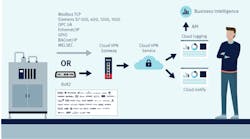Human-machine-interface (HMI) software has come a long way over my 32-year automation career. I have developed many simple HMI applications using a DOS-based operating system and experienced its rise with the introduction of Windows decades ago and the open systems of today. But it’s not the hardware I remember; it’s the HMI software.
For me, my HMI experience didn’t start with a monochrome display; I started designing operator-interface panels full of illuminated pushbuttons requiring that holes be drilled and each device be wired. There would be 25 or more of these devices controlling the machine cycle and manual functions. Every motion had an illuminated pushbutton controlling the motion and displaying its status with a light.
A one- or two-line text display was a luxury, but imagine programming a hundred or more alphanumeric status and fault messages and controlling them via ladder-diagram programming to display what’s important, especially when many needed to be displayed at the same time. It wasn’t easy, it was time-consuming and there was never enough information.
The graphic world of Windows certainly helped to simplify HMI software development in the early days. However, electronic help documents within the program were OK at best, but the user did receive a large stack of printed manuals to help guide the way. Today, the availability of online-help multimedia is important, but some HMI software suppliers do it much better than others. Take the time to view the available online training documentation and videos from beginner level to advanced. It may likely be a differentiator when selecting an HMI software package.
The multimedia training is impressive with some HMI software. And it gets even better. The HMI software of today goes well beyond the software capabilities of the past. A single HMI can connect to multiple PLCs, monitoring and controlling them all. Some act as a gateway tying multiple PLCs together, sharing data between each. While it isn’t really for real-time control, it can pass informational data back and forth such as status, batch and lot numbers, and other non-time-critical data.
It’s the higher-end HMI software packages that really expand the user experience and makes the connections. And, by connection, I mean connecting to everything on the factory floor and everything above it, as well including data historian, ERP and the cloud. The resulting HMI and SCADA enable viewing industrial applications on desktops, high-definition TVs, tablets and mobile devices. And it’s all integrated in a single development environment, the HMI software.
The right HMI software allows use of development tools, component libraries and database integration to quickly create just about any industrial HMI application needed. Pick the right software and the Industrial Internet of Things (IIoT) is literally at your fingertips—but a PC and Ethernet connections will be needed.
These applications range from a simple HMI or overall equipment efficiency displays to centralized data acquisition, device monitoring and control, and enterprise-level analytics. If it’s in the requirements, the programmer’s mind or noted as a future requirement, some HMI software can do it, so be sure to take the time to find an easy-to-use platform with the features that fit well with the IIoT.
Often, more than one developer is involved with an HMI development project. HMI software that allows multiple programmers or even an unlimited number to work with the software at the same time is an advantage. Other software packages charge for individual licenses to do the same work, but, clearly, having a single software platform that can bring together as many programmers as needed along with the data and systems needed to create multiple industrial applications is the better choice.
The HMI software may come with everything needed to create the application, but the future demands more. And don’t think the software is for a single HMI. It can be scalable for many HMI displays, and software modules can be added and developed without impacting existing applications. And it is all designed to work seamlessly with them.
Take the time to look at the capabilities of today’s HMI software. It can create just about any industrial automation solution needed whether it’s just a local machine display, a plant SCADA system, connecting to the IIoT, tracking operations using MES or beyond. HMI software can do it, or it can likely be expanded as needed. Adding the connections, reports, charts and tables for a clear view of the machine, process, system or facility has never been easier.





